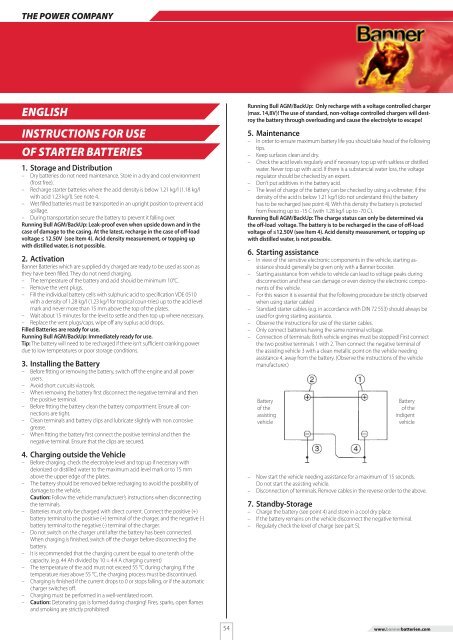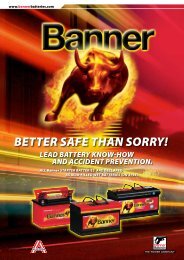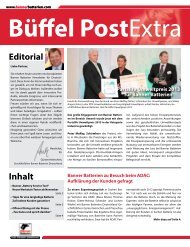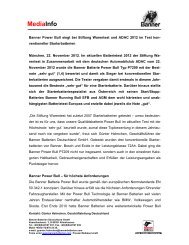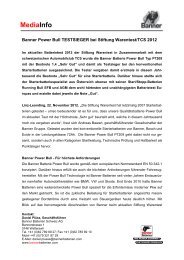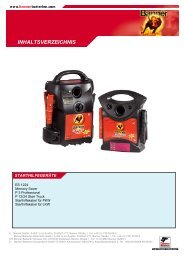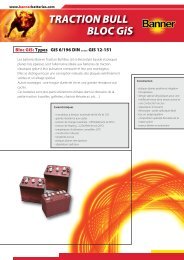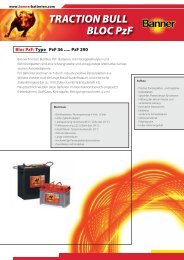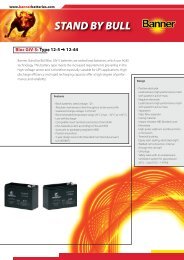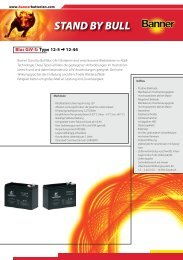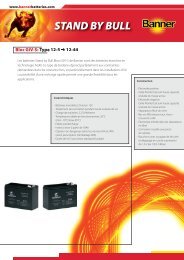ZUORDNUNGSLISTE APPLICATION LIST
ZUORDNUNGSLISTE APPLICATION LIST
ZUORDNUNGSLISTE APPLICATION LIST
You also want an ePaper? Increase the reach of your titles
YUMPU automatically turns print PDFs into web optimized ePapers that Google loves.
THE POWER COMPANY<br />
ENGLISH<br />
INSTRUCTIONS FOR USE<br />
OF STARTER BATTERIES<br />
1. Storage and Distribution<br />
– Dry batteries do not need maintenance. Store in a dry and cool environment<br />
(frost free).<br />
– Recharge starter batteries where the acid density is below 1.21 kg/l (1.18 kg/l<br />
with acid 1.23 kg/l). See note 4.<br />
– Wet filled batteries must be transported in an upright position to prevent acid<br />
spillage.<br />
– During transportation secure the battery to prevent it falling over.<br />
Running Bull AGM/BackUp: Leak-proof even when upside down and in the<br />
case of damage to the casing. At the latest, recharge in the case of off-load<br />
voltage ≤ 12.50V (see Item 4). Acid density measurement, or topping up<br />
with distilled water, is not possible.<br />
2. Activation<br />
Banner Batteries which are supplied dry charged are ready to be used as soon as<br />
they have been filled. They do not need charging.<br />
– The temperature of the battery and acid shouid be minimum 10°C.<br />
– Remove the vent plugs.<br />
– Fill the individual battery cells with sulphuric acid to specification VDE 0510<br />
with a density of 1.28 kg/l (1.23 kg/l for tropical coun-tries) up to the acid level<br />
mark and never more than 15 mm above the top of the plates.<br />
– Wait about 15 minutes for the level to settle and then top up where necessary.<br />
– Replace the vent plugs/caps, wipe off any suplus acid drops.<br />
Filled Batteries are ready for use.<br />
Running Bull AGM/BackUp: Immediately ready for use.<br />
Tip: The battery will need to be recharged if there isn’t sufficient cranking power<br />
due to low temperatures or poor storage conditions.<br />
3. Installing the Battery<br />
– Before fitting or removing the battery, switch off the engine and all power<br />
users.<br />
– Avoid short curcuits via tools.<br />
– When removing the battery first disconnect the negative terminal and then<br />
the positive terminal.<br />
– Before fitting the battery clean the battery compartment. Ensure all con-<br />
nections are tight.<br />
– Clean terminals and battery clips and lubricate slightly with non corrosive<br />
grease.<br />
– When fitting the battery first connect the positive terminal and then the<br />
negative terminal. Ensure that the clips are secured.<br />
4. Charging outside the Vehicle<br />
– Before charging, check the electrolyte level and top up if necessary with<br />
deionized or distilled water to the maximum acid level mark or to 15 mm<br />
above the upper edge of the plates.<br />
– The battery should be removed before recharging to avoid the possibility of<br />
damage to the vehicle.<br />
Caution: Follow the vehicle manufacturer’s instructions when disconnecting<br />
the terminals.<br />
– Batteries must only be charged with direct current. Connect the positive (+)<br />
battery terminal to the positive (+) terminal of the charger, and the negative (-)<br />
battery terminal to the negative (-) terminal of the charger.<br />
– Do not switch on the charger until after the battery has been connected.<br />
When charging is finished, switch off the charger before disconnecting the<br />
battery.<br />
– It is recommended that the charging current be equal to one tenth of the<br />
capacity. (e.g. 44 Ah divided by 10 = 4.4 A charging current)<br />
– The temperature of the acid must not exceed 55 °C during charging. If the<br />
temperature rises above 55 °C, the charging process must be discontinued.<br />
– Charging is finished if the current drops to 0 or stops falling, or if the automatic<br />
charger switches off.<br />
– Charging must be performed in a well-ventilated room.<br />
– Caution: Detonating gas is formed during charging! Fires, sparks, open flames<br />
and smoking are strictly prohibited!<br />
54<br />
Running Bull AGM/BackUp: Only recharge with a voltage controlled charger<br />
(max. 14,8V)! The use of standard, non-voltage controlled chargers will destroy<br />
the battery through overloading and cause the electrolyte to escape!<br />
5. Maintenance<br />
– In order to ensure maximum battery life you should take head of the following<br />
tips.<br />
– Keep surfaces clean and dry.<br />
– Check the acid levels regularly and if necessary top up with saltless or distilled<br />
water. Never top up with acid. If there is a substancial water loss, the voltage<br />
regulator should be checked by an expert.<br />
– Don’t put additives in the battery acid.<br />
– The level of charge of the battery can be checked by using a voltmeter, if the<br />
density of the acid is below 1.21 kg/l (do not understand this) the battery<br />
has to be recharged (see point 4). With this density the battery is protected<br />
from freezing up to -15 C (with 1.28 kg/l up to -70 C).<br />
Running Bull AGM/BackUp: The charge status can only be determined via<br />
the off-load voltage. The battery is to be recharged in the case of off-load<br />
voltage of ≤12.50V (see Item 4). Acid density measurement, or topping up<br />
with distilled water, is not possible.<br />
6. Starting assistance<br />
– In view of the sensitive electronic components in the vehicle, starting as-<br />
sistance should generally be given only with a Banner booster.<br />
– Starting assistance from vehicle to vehicle can lead to voltage peaks during<br />
disconnection and these can damage or even destroy the electronic compo-<br />
nents of the vehicle.<br />
– For this reason it is essential that the following procedure be strictly observed<br />
when using starter cables!<br />
– Standard starter cables (e.g. in accordance with DIN 72 553) should always be<br />
used for giving starting assistance.<br />
– Observe the instructions for use of the starter cables.<br />
– Only connect batteries having the same nominal voltage.<br />
– Connection of terminals: Both vehicle engines must be stopped! First connect<br />
the two positive terminals 1 with 2. Then connect the negative terminal of<br />
the assisting vehicle 3 with a clean metallic point on the vehicle needing<br />
assistance 4, away from the battery. (Observe the instructions of the vehicle<br />
manufacturer.)<br />
Battery<br />
of the<br />
assisting<br />
vehicle<br />
Battery<br />
of the<br />
indigent<br />
vehicle<br />
– Now start the vehicle needing assistance for a maximum of 15 seconds.<br />
Do not start the assisting vehicle.<br />
– Disconnection of terminals. Remove cables in the reverse order to the above.<br />
7. Standby-Storage<br />
– Charge the battery (see point 4) and store in a cool dry place.<br />
– If the battery remains on the vehicle disconnect the negative terminal.<br />
– Regularly check the level of charge (see part 5).<br />
www.bannerbatterien.com


